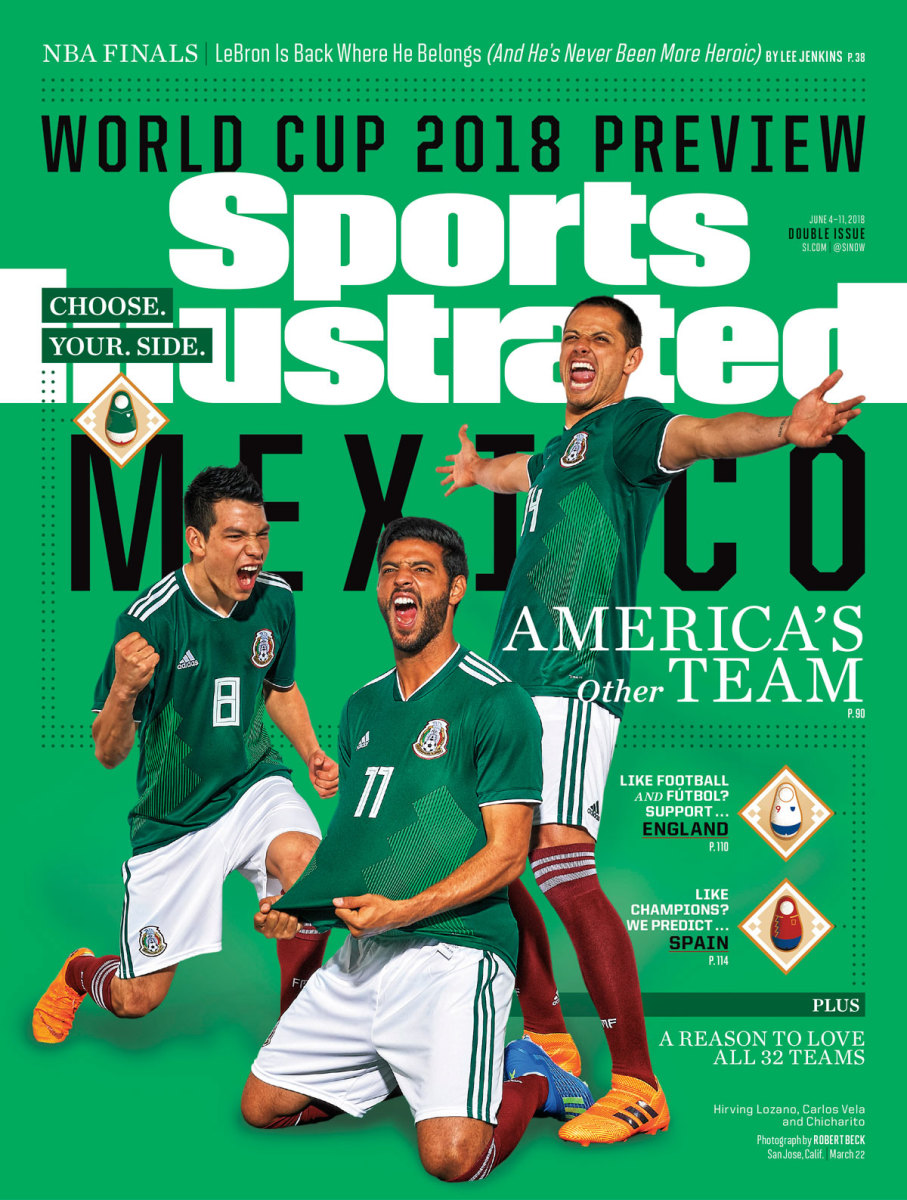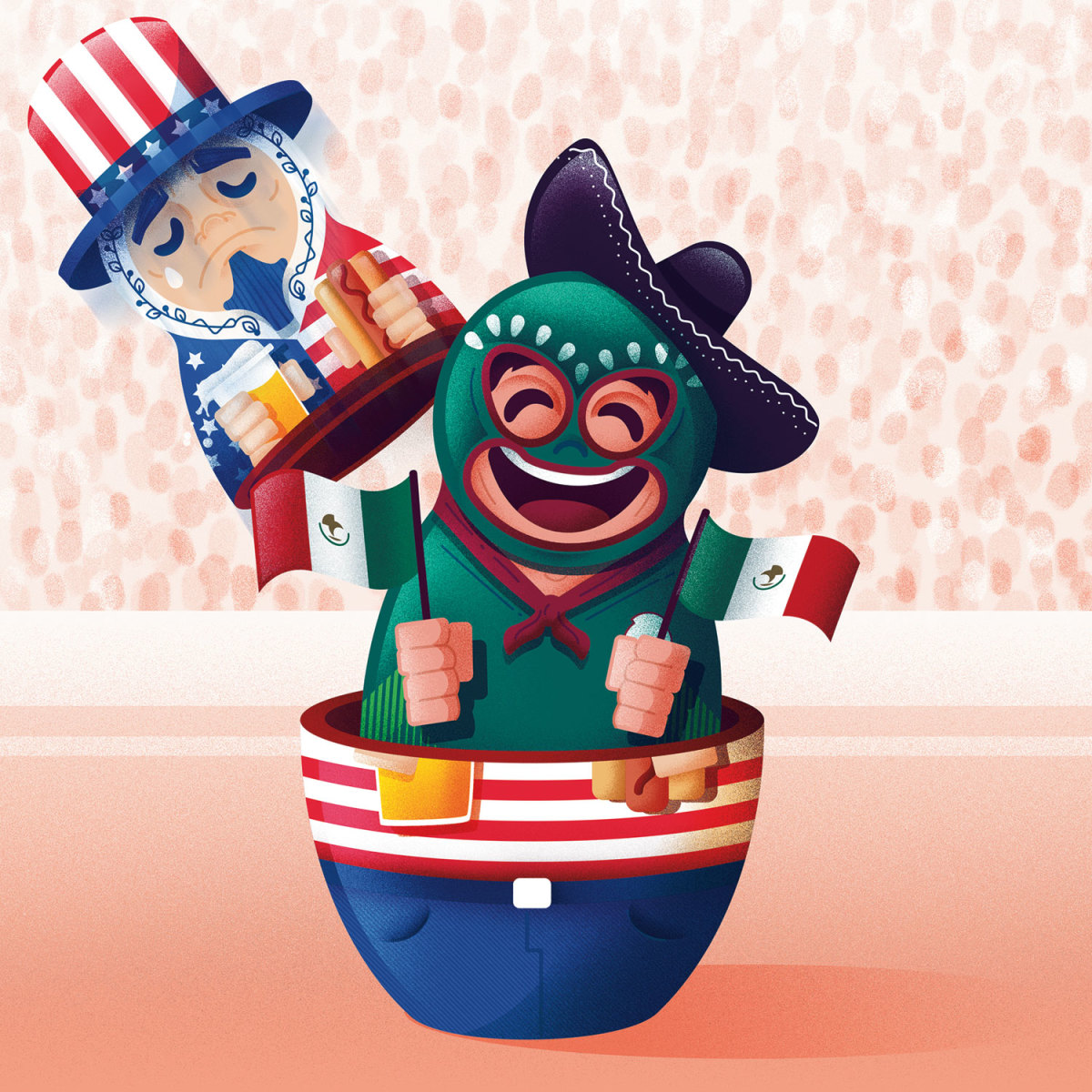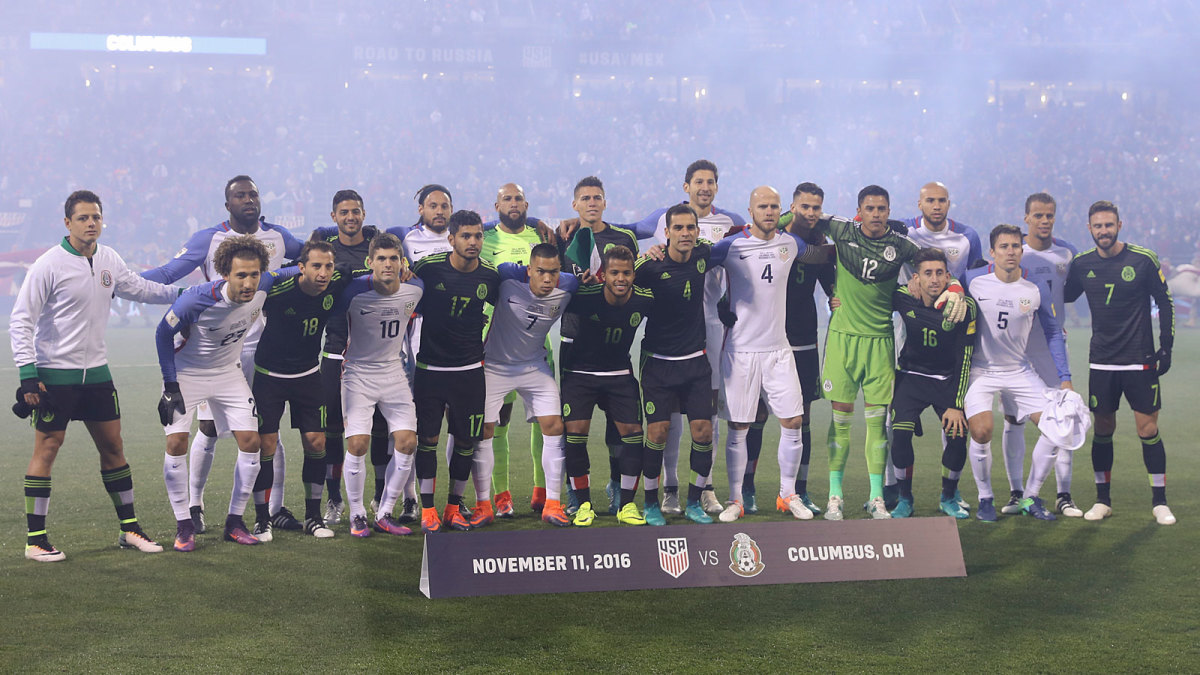United States of El Tri: Mexico Owns America's World Cup Spotlight

The man they call El Matador signed autographs and posed for selfies. Luis Hernández greeted fans who could recall every one of his 35 goals for Mexico, and some who hadn’t been born when the forward retired in 2004. It was a Thursday afternoon, and a couple hundred supporters turned out to celebrate a national icon, many wearing green or carrying props—a replica World Cup trophy, an oversized cutout of Hernández’s smiling face...
They waited for El Matador outside a Wells Fargo bank adjacent to a San Jose strip mall, yards from a Ross Dress for Less and 500 miles north of the Mexican border, at the intersection of two nations that often run in parallel, one just as authentic and American as the other.
Hernández tried to explain the crowd of Mexican-Americans gathered on a weekday in March, one day before El Tri faced Iceland in a Bay Area friendly.
“The passion of the fans here, they live it more," he said in Spanish. "They feel love for their land and for the Mexican national team."
But the word he used for land, tierra, refers to more than the square mileage enclosed by a border or the prevailing bureaucracy. A nation is just as much about tradition and shared memory. Sports can be incredibly effective at tapping into the reservoir of what Hernández called sentimentalismo. It's so intuitively obvious, it's become a marketing cliche. Red Sox Nation and Raider Nation don’t exactly have seats on the U.N. Security Council, but everyone understands what those slogans represent.
Because their sentimentalismo is real and undying, and because they number in the millions, Mexico fans show up time and again in the U.S., to stadiums or strip malls, in the cities you'd expect and others—Charlotte, Nashville, Seattle—you might not. That connection between country and nation is only deepening this spring, as their team prepares for a World Cup that its main on-field rival will miss. El Tri, in fact, are an integral part of American soccer—so much so that since the start of 2010, Mexico has played more than twice as many times on U.S. soil as on its own. That’s an astonishing, unique and counterintuitive bit of trivia that speaks to the power of national identity as well as to the raw popularity of the team that binds a diaspora. The Mexican national soccer team may be the most broadly popular sports outfit in the United States.

Like so many of his countrymen, Javier Hernández, the star striker for the Mexican squad heading to Russia, has family in the U.S. His aunt lives in San Francisco. The 30-year-old who goes by Chicharito is a footballing icon. He's prolific, charismatic and cosmopolitan, the leading scorer in El Tri history and a man who's played for some of the world’s biggest clubs. And he made his national team debut in Dallas, in a 2009 friendly against Colombia. As he sat in a conference room inside his team’s hotel in San Jose—abutting the Plaza de César Chávez—a couple dozen fans gathered in the courtyard below, hoping to glimpse one of their heroes walking across the second-floor skyway.
It was common for Mexican players of El Matador’s generation to spend most or all of their pro careers at home; the soccer culture was insular. But Chicharito’s national team is full of players from European leagues or MLS—men who speak English and who are citizens of a shrinking world. For Chicharito, staging national-team matches in the U.S. makes sense.
“Why not? We are neighbors. We’ve been close since the beginning of the world," he said earnestly, tapping on a table for emphasis. “It’s different [playing here]. You can see now people waiting for us, just for a picture, for an autograph. Then, you go to the stadium, and it’s full—completely full.”
That leaves an impression. “It makes a sound around the world,” he says.
Chicharito claimed he’s had teammates in Europe who saw highlights during an international break ask for clarification about where his game took place.
“They ask me, 'You play in Mexico?' No. We play in USA.”
At the end of that week in San Jose, El Tri defeated Iceland before nearly 69,000 fans at Levi’s Stadium. Chicharito & Co. then left for Dallas, where more than 79,000 attended a loss to Croatia. Combined U.S. TV viewership for those two exhibitions on Fox (which has been paying to broadcast Mexico games in English since 2016) and Univision exceeded 4.5 million. The next two most-watched games that week were Liga MX affairs. A U.S.-Paraguay friendly ranked fifth, at 925,000.
“There’s no denying the Hispanic demographic in the United States,” says David Neal, who experienced its heft at Univision before becoming VP of production for Fox Sports in 2012. “It’s the latest growing demo and shows no signs of slowing down. That’s a simple fact. You would be in error to not pay attention to that simple fact, and it coincides with the explosive growth of the game.”

The atmosphere and attention surrounding El Tri in the U.S. is such that Mexico’s coach, Juan Carlos Osorio—a Colombian who graduated from Southern Connecticut State and managed the Chicago Fire and the New York Red Bulls—believes these American-soil friendlies help prepare his players for a World Cup. For El Tri exhibition matches in Mexico, he says, “the crowds are very low and there is no football environment.” But an engaged throng of 70,000 can test a player's nerves.
It’s also lucrative. There’s been a cultural and economic awakening in the U.S., where an increasing number of brands have embraced the power of the Latino and Mexican-American markets. El Tri’s 2018 U.S. tour has 15 corporate sponsors, each hoping to reach a greater portion of a country that has the second-largest Spanish-speaking population on the planet. According to Census Bureau data, in 2016 there were more than 36 million U.S. residents who identified as Mexican or Mexican-American. That’s more than 11% of the country—and according to Soccer United Marketing, there are that many, or more, El Tri fans in the U.S.
“One of the biggest misconceptions,” though, says SUM senior vice president Camilo Durana, “is that [this Mexican] fan base is only first-generation [immigrants]. In reality, we find that only 28% are first-generation, and 72% are second-generation or higher. A lot of our fans are bilingual, bicultural and, in many cases, English-preferred.”
Our fans? Well, yes. Because SUM, which is part and parcel of MLS, is in business with the Mexican federation (FMF). Since 2003, SUM and the FMF have worked together to stage roughly five friendly matches per year across the U.S. (Add in official tournaments such as the Concacaf Gold Cup, which is also promoted by SUM and played in the U.S., and you get that crazy stat about the number of El Tri games north of the border.) SUM pays the Mexican federation an appearance fee and in turn sells sponsorships and tickets. Fans flock in from an average of 30 states and participate in tailgates, parties and promotional events like El Matador’s at the bank. A pregame walk through the parking lots surrounding Levi’s Stadium in March was testament to SUM’s research: They were filled with green jerseys and unaccented English.
“There are not only bigger numbers of die-hard Mexico fans in American than there are [U.S.] fans, but the passion that they have is unlike anything other sports in this country can understand. And you see it every time Mexico plays in the States,” says Landon Donovan, who lived and breathed the USA-Mexico rivalry throughout a record-breaking 14-year international career.
Masters of Modern Soccer: Chicharito and the Art of Mexico's Synchronization
At many Mexico games, Sergio Tristan is one of those fans. His parents arrived from San Luis Potosí during the immigration boom that began in the 1970s. Those families crossed the border, settled in tight-knit communities, maintained native traditions and labored to give their children a better life. Born and raised in Austin, Tristan is now a Texas graduate, a lawyer at a government agency and a U.S. Army veteran—an El Tri fan with a Bronze Star. He’s had his patriotic credentials challenged, he says, but he insists there’s nothing wrong with loving two nations in a world of fluid cultures and permeable walls. In 2013, Tristan founded Pancho Villa’s Army, a supporters club for U.S.-based Mexico fans that has 5,000-plus members. PVA travels the country and the world—there will be roughly 80 of them in Russia—to support El Tri.
“We are dipped in both cultures—we eat burgers the same way we eat tacos; our education is in English, and we consume our media in English—but we’re also Mexican,” Tristan says. “Mexico games aren’t just soccer games. [They’re] a moment in time where we can be proud of our culture and surround ourselves with our language, food and music, and hang out with people just like us.”
The communities Tristan’s parents and their peers built, he says, have mostly bled into the American fabric. Sundays scheduled around church, barbecues and televised Mexican league matches are now the stuff of wistful memory. But when Mexico plays, there’s a chance to reconnect. For a couple of hours, whenever and wherever El Tri take the field, those Sundays are relived.
“It’s really our final link to where we come from,” Tristan says, “and to the identity our parents gave us.”
That’s a powerful thing. By now you’ve heard the stories of dual-national players, often American-born, facing the difficult decision between playing for the U.S. or Mexico. Familiarity and fusion have added unexpected wrinkles to the on-field rivalry.
“The world in general is smaller and more connected, but the soccer world especially. What you learn quickly is you end up playing with a lot of different players, or you have friends who’ve played with certain players. The nastiness in that way has changed,” says Donovan, a Southern Californian whose life-long exposure to Mexican culture, and his increasing comfort, helped lead him to return to the field with Club León this year.
“The connection is there. Even the rivalry we have against the USA, talking about soccer is like the only thing that can tear us apart,” Chicharito says.

The battle for hearts, minds and points now plays out on increasingly equal footing, and sometimes that parity leads to unexpected expressions of unity. In November 2016, three days after the election of an American president who was promising to build a U.S.-Mexico border wall, the two national teams posed together, arms linked, for a photo before their World Cup qualifier in Columbus, Ohio. It was an emotional display of common bonds—“You need to separate that we are human beings,” Chicharito says—sparked by a FaceTime call from U.S. midfielders Michael Bradley and Jermaine Jones to Jones’s future L.A. Galaxy teammate, Mexican forward Giovani dos Santos.
“Everybody wants to talk about ‘We need a soccer culture,’” says Bradley, the U.S. captain. “Well, guess what? Part of our soccer culture is that there are millions of people across our country who come from other places, and these people have strong ties to other teams. That’s us. That’s unique. And I don’t think that’s anything anyone should be up in arms about.”
In other words, cheering for a foreign national team in your own country is quintessentially American. No one expects staunch U.S. fans to don green-and-red lucha libre masks and wave Mexican flags this summer, but those same diehards understand the reason their team hosts qualifiers against Mexico in a small stadium in central Ohio. You may not be a Mexico fan, but you probably have neighbors or coworkers who are. And at the World Cup, El Tri will be something very close to this country’s team.
FMF general secretary Guillermo Cantú played in a few of those rough-and-tumble U.S.-Mexico games of the early 1990s. He was born in Torreón, then went to high school in Massachusetts. After trying to lead El Tri to the trophy in Russia, he’ll continue to work on the joint bid to bring the tournament to the U.S., Mexico and Canada in 2026. He said the photogenic moment in Columbus left him in tears.
“We’ve come a long way since [I played],” Cantú says. “We’ve learned a lot of things. We respect each other. But that’s what happens when you actually meet people and have a conversation.”
This summer, he notes and hopes, presents an opportunity for strengthening the U.S.-Mexico relationship.
“Just open the door and start looking for the guys in green. It’s very easy, especially in the World Cup. There will be many, many green shirts,” Cantú says. “Just follow them. If you don’t like the party...”
